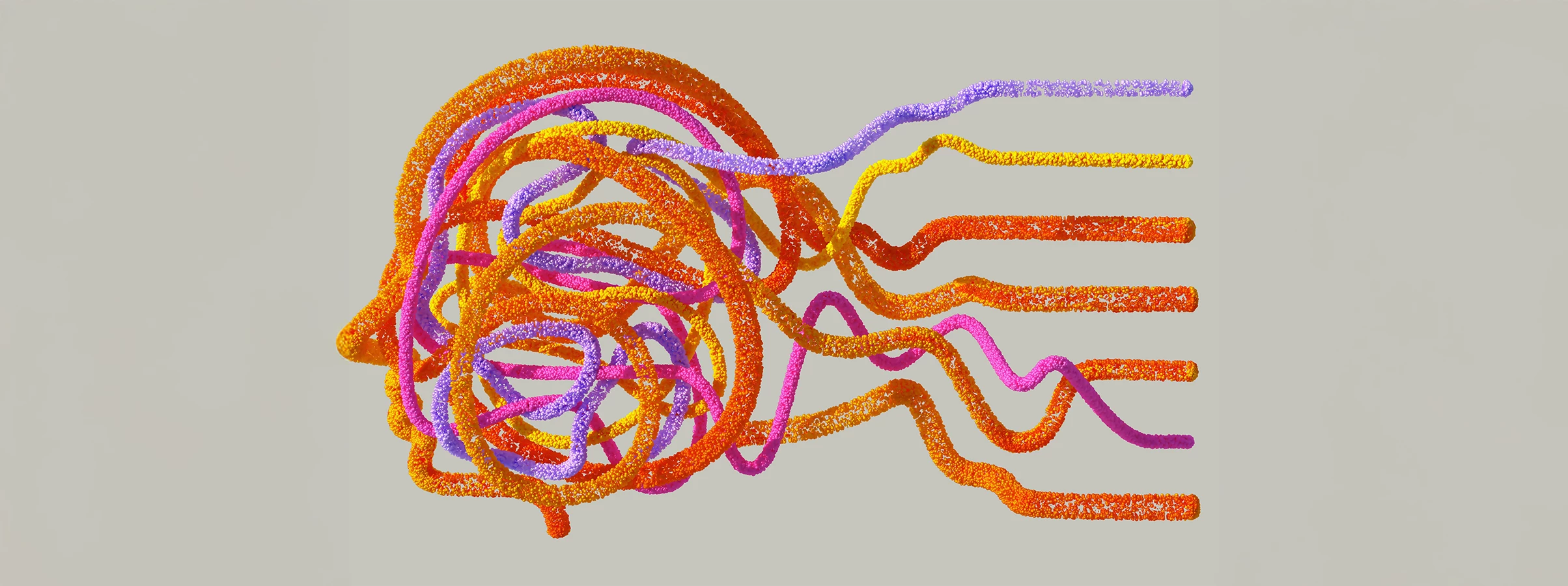How people REALLY use ChatGPT 🤔
5 November 2025
Introduction
Technology is changing our world at a pace that is difficult to comprehend. Just yesterday, smartphones seemed like a miracle, and today we are already discussing artificial intelligence as part of our daily routine, rather than something out of science fiction. 🤯
Perhaps no other technology has caused as much excitement in recent times as the emergence of ChatGPT. In a matter of months, it burst into our lives, promising to be the perfect personal assistant, a brilliant tutor, a tireless programmer, or even a sensitive conversation partner.
While industry experts discuss economic models and the ethical implications of using AI, the question arises: how do millions of ordinary users actually use this tool? Are we really solving critical problems and optimizing workflows, or are we just asking it to come up with funny captions for Instagram photos?

Photo by fauxels
To finally go beyond assumptions, researchers at OpenAI (the company that created ChatGPT) teamed up with scientists from Duke and Harvard to conduct a large-scale study based on real conversations from more than 700 million users. Thanks to this unprecedented amount of data, researchers were able to go beyond traditional surveys, which often give a distorted picture, and focus on actual user behavior.
It is important to note that the study was conducted with the utmost respect for user privacy. The analysis was based solely on aggregated, anonymized data and was performed using a secure “data clean room” protocol. This means that no private correspondence was read by humans.
In this article, we will dive into the results of this study (the full version is available at the link) and look at the real, rather than imaginary, picture of ChatGPT usage. Get ready, some of the findings will definitely surprise you. 🫢
How AI became a daily habit
We all remember the moment when ChatGPT “exploded” in the news. Very soon, this tool went from being an interesting novelty to becoming part of our working day and personal lives. The speed with which AI has conquered the world is simply unprecedented in the history of consumer technology.

Photo by Andrea Piacquadio
To understand the scale of the revolution, just look at the weekly active user figures:
- Just five days after its launch (by December 5, 2022), over 1 million users had registered.
- A year later, that number exceeded 100 million.
- After two years, it reached 350 million.
- By July 2025, ChatGPT had over 700 million total weekly active users, representing nearly 10% of the world's adult population.
The growth chart for active users shows a rapid, almost vertical rise, especially in 2025, indicating continuous and widespread adoption of the technology.
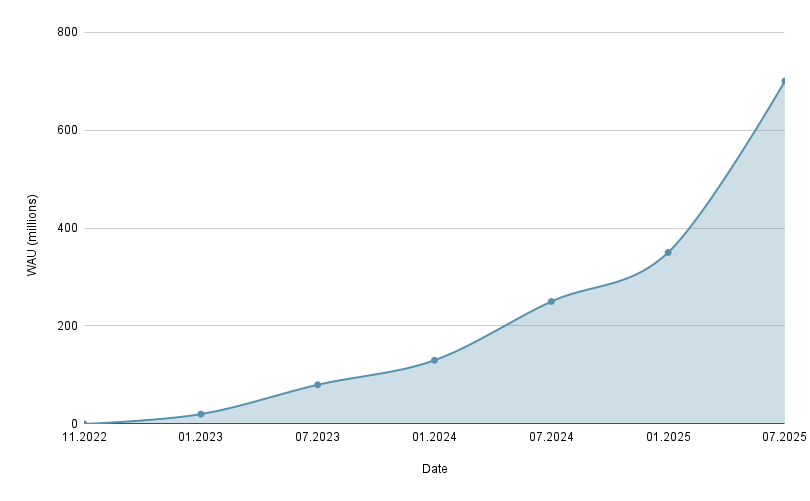
Active user chart
Why do people need ChatGPT? An unexpected discovery
If you thought that most users utilize ChatGPT to expedite work tasks, write reports, or optimize Excel spreadsheets, prepare to be surprised. Statistics compiled by researchers illustrate a striking imbalance, demonstrating that AI has become our universal personal assistant, while its professional role has taken a back seat.
According to data from June 2025, the share of non-work-related messages skyrocketed to 73% of total consumer usage. In contrast, usage for professional duties accounted for a modest 27%.
📌 According to the study, three out of four conversations deal with personal life issues rather than office tasks.
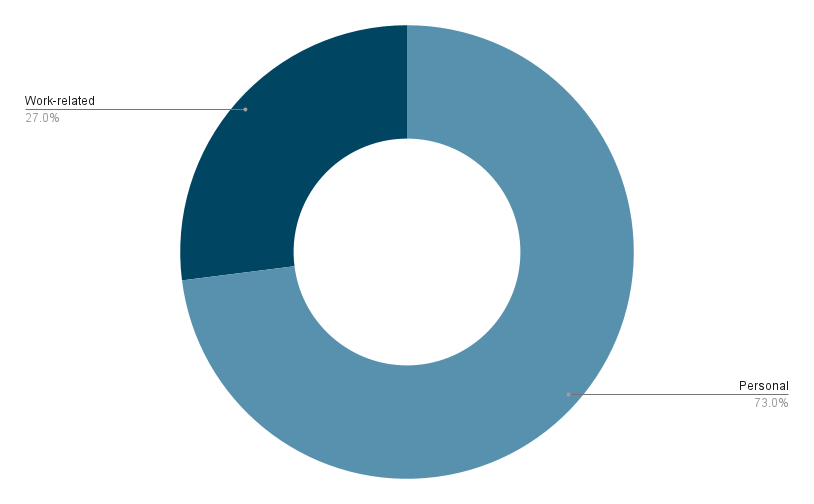
Distribution of requests (work requests vs. personal questions)
After analyzing billions of conversations, researchers found that nearly 78% of all queries centered around three key topics:
- The most common category is Practical Guidance 🧰. It covers all instances when people turn to AI for instructions, advice on solving everyday or financial problems, or support in making difficult life decisions.
- The second dominant area is Seeking Information 🔍. Many users now use ChatGPT as an alternative to traditional web search, preferring the conversational and focused format of the model's responses to sifting through endless links in search engines.
- The third key category is Writing 📝. It is universal and covers both the creation of working documents and personal texts.
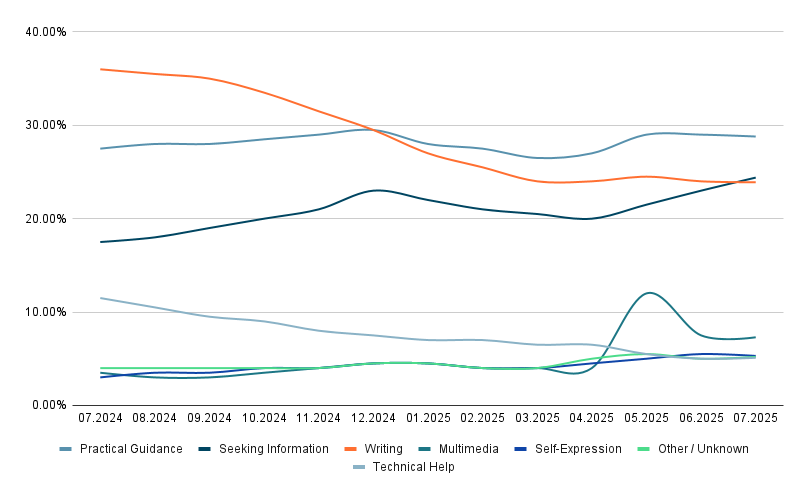
Distribution of chats by communication topics
Interestingly, despite initial expectations, some of the most hyped AI capabilities account for a negligible share of total usage. For example, computer programming accounts for only 4.2% of all reports, which is significantly lower than experts predicted.
User intentions
When we analyze ChatGPT usage solely based on conversation topics, we only see part of the picture. To understand the true, deeper value of AI, researchers decided to classify messages not by content, but by the user's desired intent. They identified three main categories:
- 🙋♀️ Doing. This covers messages in which the user wants to perform a specific task, such as “write me an email,” “translate this paragraph,” or “create a list of ideas.”
- 🤷♂️ Asking. This category includes messages that seek guidance, advice, or information needed to make a decision, such as “what is the best choice in this situation?” or “explain this complex concept to me.”
- 💁 Expressing. This is the smallest category and includes messages in which the user expresses views or feelings without requesting a specific action or information.
📌 The distribution of these intentions is extremely revealing: it emphasizes that ChatGPT is more of an advisor than an executor.
Almost half of all messages, or about 49%, fall into the “ Asking” category, while requests to perform specific tasks account for approximately 40%. This preference indicates that most users utilize AI as a powerful tool for decision-making and reflection.
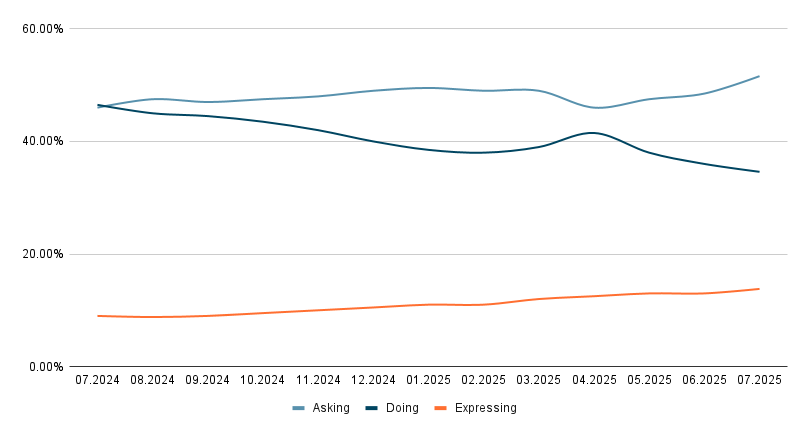
Distribution of messages according to user intent
More importantly, the dynamics over time confirm this trend. Over the past year, the use of the “Questions” category has grown significantly faster than the performance of specific actions. This signals a sustained shift: people increasingly value AI for its ability to assist in thinking and choosing, rather than just performing.
Quality of interactions and trust in AI
The growth in active users and messages is undoubtedly impressive, but in their study, OpenAI experts also decided to assess the quality of these interactions and whether users trust the responses they receive.
To evaluate the quality of responses, the researchers used an automated classifier that analyzed the user's next reply in the dialogue and divided it into three categories: Good, Bad, and Unknown.
At the end of 2024, the share of good interactions was approximately 48%, but by July 2025, it had risen to over 57%. This indicates a steady improvement in the quality of the model and an increase in user confidence in its responses.
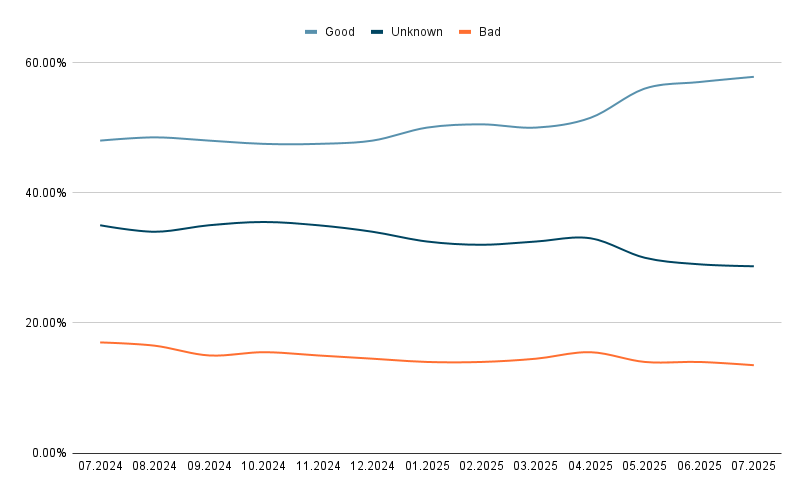
Message quality rating
Interestingly, this high satisfaction is not uniform. Researchers have found a fundamental difference in quality between the two main user intentions we discussed earlier: Asking (requesting advice) and Doing (performing a task).
- Messages in the Asking category, in which users seek guidance, information, or help in making a decision, were rated higher in quality than messages in the Doing category.
- Low satisfaction scores were recorded in areas where the need to perform a specific, often technical, action dominates. This does not mean that ChatGPT cannot handle code or text; rather, it indicates that users have higher and more critical expectations when asking the model to perform tasks for them.
User profile. Who exactly creates ChatGPT trends?
The phenomenal growth in popularity of AI would not have been possible without a wide range of users who have integrated this technology into their daily lives. Research by OpenAI has enabled us to outline a portrait of the average ChatGPT user.
It is interesting to note that immediately after the launch of ChatGPT, communication with AI was predominantly male. In the early stages, about 80% of active users had names that are traditionally considered male. However, over the course of a year, this gender gap has not only narrowed — it has likely disappeared entirely. As of July 2025, more than half of weekly active users had names that are typically considered female. This is clear evidence that the model has successfully moved beyond its initial “technical” audience and has become a universal tool for both genders.

Photo by Michelangelo Buonarroti
In terms of age, ChatGPT is most actively used by young people. About half of all messages sent by adult users came from people under the age of 26. And although researchers have recorded an increase in the proportion of older users in recent months, ChatGPT remains most popular among the younger generation.
From a geographical perspective, scientists have made an incredible discovery. Over the past year, ChatGPT usage has grown fastest in low- and middle-income countries. For the populations of these countries, ChatGPT can serve as a powerful educational resource and advisor, providing access to information and support that was previously unavailable.
🙈 For those who are too lazy to read. Key findings
- 👥 ChatGPT has reached over 700 million active users per week, which is equivalent to about 10% of the world's adult population, and is demonstrating unprecedented growth rates.
- About 73% of interactions with ChatGPT are not work-related, indicating that the model is used primarily in everyday life rather than strictly for professional tasks.
- The most common use cases fall into three categories: getting practical advice, searching for information as an alternative to traditional web search, and writing various types of text.
- Despite the media hype, computer programming 👨🏻💻 accounts for only 4.2% of queries.
- Analysis of user intent shows that 49% of messages are aimed at getting advice or explanations 🙋♀️ (Asking), while approximately 40% are aimed at performing specific tasks (Doing); the rest are messages with emotional or personal content.
- The quality of responses and the level of trust in the model are steadily increasing: the share of positive interactions 🙂 grew from 48% at the end of 2024 to over 57% in July 2025.
- The gender distribution of users has changed significantly: while in the first year, approximately 80% of the active audience were men 👨💼, as of mid-2025, more than half of the users are women.
- 🧑🏻 Young people are the most active group. Approximately half of all messages come from people under the age of 26, although growth is observed in all age groups.
- The most dynamic growth in ChatGPT usage is occurring 🌍 in low- and middle-income countries, where the model serves as an affordable tool for education and consultation, partially compensating for the lack of local resources.
